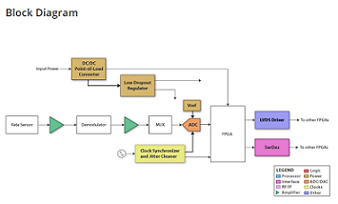
Gyro Rate Sensors determine the attitude by measuring the rate of rotation of the spacecraft. They are located internal to the spacecraft and work at all points in an orbit. Since they measure a change instead of absolute attitude, gyroscopes must be used along with other attitude hardware to obtain full measurements. These sensors can be used for satellite pointing as we as stabilization. At least three gyro sensors are used in a satellite.
The top considerations for space designs are power, size, weight, and performance. Thermal performance is critical in high power devices. Due to the environment, cooling is done through conduction. As power components increase their efficiency and shrink their footprint, the trend is to move towards distributed power systems which allow the insertion of more point of load DC to DC convertors. As voltages decrease, noise margins become more critical, thus increasing the need for low noise supplies and driving the need for lower drop out regulators situated near the load. Models (IBIS for digital parts, Pspice for analog parts) are often used to analyze the design. Design functionality can be broken up in multiple blocks or circuit cards and maybe done by separate designers or even subcontracted to another company.
To promote reliability, floating metal is often not allowed in long term applications. Floating inputs are avoided and No Connect pins are strongly scrutinized. Overshoot/Undershoot conditions are analyzed to ensure IC’s are not overly stressed. Insertion of new technology is difficult due to multiple reasons: budget, analysis effort, qualification, and trust in proven way of doing things. This can be overcome by solving design critical issues such as: power, performance, reliability and footprint. Designs are often done in multiple board spins offering multiple chances for technology insertion into the final flight design (Prototype, EM/EDU, and Flight). Oftentimes product availability is met through criteria such as: redundancy, self-checking, TMR schemes, error checking.
Ionizing radiation found in natural space environments can strongly affect the operation of electronic circuits used in space applications. HiRel performs total dose testing on space-qualified, QML Class-V new product releases in order to determine how much radiation our devices can absorb before device degradation occurs. The test results for select devices are available at www.ti.com/radiation. For additional information, click here
Download full block diagram below
Advertisement

Learn more about Texas Instruments





